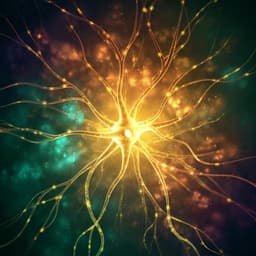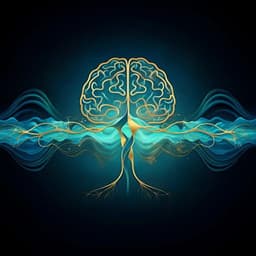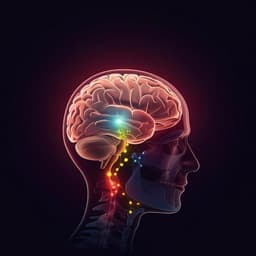
Medicine and Health
Music prevents stress-induced depression and anxiety-like behavior in mice
Q. Fu, R. Qiu, et al.
Discover how music can be a powerful tool in combating stress-induced depression and anxiety, as revealed by Qiang Fu, Rui Qiu, Lei Chen, Yuewen Chen, Wen Qi, and Yong Cheng. This groundbreaking study on mice demonstrates how music exposure can restore key physiological markers and thwart harmful effects of stress.
~3 min • Beginner • English
Introduction
The study addresses whether music can prevent stress-induced depression and anxiety-like behaviors. Depression is highly prevalent, impairs psychosocial function, and is projected to be a leading contributor to disability by 2030. Its etiology is complex, involving neurotrophic factors, inflammatory cytokines, the hypothalamus-pituitary-adrenal (HPA) axis, and oxidative stress systems. Hyperactivation of the HPA axis, elevated cortisol/corticosterone, and decreased BDNF are implicated in depression. Existing treatments have limited efficacy, side effects, and blood–brain barrier challenges, highlighting the need for alternative, low-risk interventions. Music therapy is widely used as an adjunct in mental health and may alleviate stress and depressive symptoms, yet mechanistic evidence for prevention is limited. This study tests whether nightly exposure to a curated set of music pieces can prevent depression- and anxiety-like behaviors in a mouse CUMS model and explores potential mechanisms involving HPA axis homeostasis, oxidative stress, inflammation, neurogenesis, and neuronal survival.
Literature Review
The authors reference epidemiological and mechanistic literature demonstrating the burden of depression, involvement of the HPA axis and corticosterone, roles of neurotrophic factors (e.g., BDNF), oxidative stress markers (NO, SOD, GSH-Px, MDA, CAT, T-AOC), and neuroinflammation (IL-6, IL-1β, TNF-α, TGF-β, IL-10), as well as the contribution of microglia and astrocytes to neurogenesis. Prior clinical and preclinical work indicates music therapy can relieve stress and improve depressive symptoms, but prevention via music and underlying mechanisms are underexplored. The review sets the rationale that music may modulate stress biology, including HPA axis activity and neuroimmune-oxidative pathways, thereby preventing depressive phenotypes.
Methodology
Animals: Male C57BL/6 mice, 7 weeks old (22 ± 1.5 g), were housed at 23 ± 1 °C, 50 ± 1% humidity, 12-h light/dark cycle (lights on 8:00–20:00), with ad libitum food and water. Groups: Control (n=6), CUMS (n=10), Music (n=6), CUMS+Music (n=14). All procedures followed NIH guidelines and were approved by Minzu University of China IACUC.
CUMS protocol: Mice were singly housed and exposed daily to three different stressors drawn from restraint (4 h), cage tilt (45° for 24 h), wet bedding (24 h), food/water deprivation (24 h), tail nip (1 cm for 3 min), cold water swim (4 °C for 3 min), and light inversion (24 h), for 28 days.
Music exposure: CUMS+Music mice listened to music nightly for 1.5 h (20:30–22:00) during the 28-day period; Music-only mice received music without CUMS. Playback occurred ~2 m from cages with randomized order from a curated list of 25 tracks spanning Baroque, Classical, Romantic, Eastern/Western instrumental and vocal styles (piano, flute, harp, violin, guqin, cucurbit flute; including traditional Chinese ethnic/folk music). Frequency ranges for pieces are provided (Table 1); all content was within audible range for mice and humans (<20 kHz).
Behavioral testing: Conducted on day 30 (2nd day after completing 28 days of CUMS/music), in a quiet room, with mice acclimated ≥3 h. Blinded scoring. Tests included:
- Sucrose Preference Test (SPT): 1% sucrose habituation (3 days), 24 h two-bottle choice baseline (water vs sucrose), then 12 h test with bottle positions switched every 6 h; sucrose preference (%) = sucrose intake/total intake × 100.
- Open Field Test (OFT): arena divided into 16 squares; after 2 min habituation, 3 min recording of total distance, center time, and center crossings.
- Tail Suspension Test (TST): suspended by tail (tape ~1 cm from tip); after 1 min habituation, immobility measured over 5 min (max 5 min).
- Novelty-Suppressed Feeding (NSF): 24 h food deprivation; latency to begin eating in a 50×50×45 cm arena with food on central filter paper.
- Elevated Plus Maze (EPM): two open and two closed arms; 5 min test after 30–45 min room acclimation; open/closed arm entries and time recorded; apparatus cleaned with 30% isopropanol between trials.
Molecular and histological assays:
- qRT-PCR: Total RNA from hippocampus and prefrontal cortex (TRIzol). SYBR Green qPCR for IL-6, IL-1β, iNOS, TNF-α, TGF-β, IL-10, Bax, Bcl-2, BDNF, normalized to Actin (primer sequences in Table 2).
- Oxidative stress markers: Serum (retro-orbital collection; serum isolated by centrifugation) and tissues (hippocampus, prefrontal cortex) assayed for NO, SOD, GSH-Px, MDA, CAT, corticosterone, and T-AOC using commercial kits (Nanjing Jiancheng Bioengineering Institute).
- Immunofluorescence: After perfusion and fixation, 35 µm coronal sections processed and stained with primary antibodies: DCX (immature neurons), MAP2 (neurons), GFAP (astrocytes), IBA1 (microglia), followed by Alexa Fluor-conjugated secondary antibodies and DAPI; imaged on Leica TCS SP8 confocal microscope. Quantified cell numbers and mean fluorescence intensity in dentate gyrus (DG).
Statistics: GraphPad Prism 5.0; one-way ANOVA with Tukey’s multiple comparisons; data as mean ± SEM; significance at P < 0.05.
Key Findings
- Behavior: CUMS induced depression- and anxiety-like phenotypes: reduced center time and total distance in OFT; increased latency to eat in NSF; reduced open arm time/entries in EPM; increased immobility in TST; decreased sucrose preference in SPT. Music exposure (CUMS+Music) prevented these changes, with behavior comparable to controls and in some cases increased open arm time in EPM for Music and CUMS+Music groups. Group sizes: Control/Music n=6, CUMS n=10, CUMS+Music n=14; significance indicated as *P<0.05, **P<0.01, ***P<0.001.
- Oxidative stress: CUMS altered NO, SOD, GSH-Px (reported as GSH in figures), MDA, CAT, and T-AOC in serum and in hippocampus and prefrontal cortex (indicative of oxidative stress damage). Music prevented these abnormalities, with CUMS+Music values not differing from controls (Figure 2A–L).
- Inflammation: Pro-inflammatory cytokine mRNAs (IL-6, IL-1β, iNOS, TNF-α, TGF-β) were upregulated in hippocampus and prefrontal cortex of CUMS mice; anti-inflammatory IL-10 was downregulated. Music prevented these changes, normalizing pro-inflammatory transcripts and elevating IL-10 above control in CUMS+Music (Figure 3A–F). Immunofluorescence showed increased IBA1+ microglia and GFAP+ astrocytes in the DG with CUMS, which was prevented by music (Figure 3G–J).
- Neuronal survival and neurogenesis: CUMS reduced DCX+ immature neuron counts and MAP2 intensity in DG, increased pro-apoptotic Bax mRNA, and decreased anti-apoptotic Bcl-2 mRNA in hippocampus and prefrontal cortex. Music prevented neuronal loss and apoptosis-related gene dysregulation (Figure 4A–F).
- HPA axis and neurotrophic support: CUMS increased corticosterone and decreased BDNF in hippocampus and cortex; music normalized corticosterone and restored BDNF levels, suggesting preserved HPA axis homeostasis and neurotrophic support (described in Results/Discussion).
Discussion
The study demonstrates that nightly music exposure prevents the development of stress-induced depression- and anxiety-like behaviors in a CUMS model. Mechanistically, music appears to maintain HPA axis equilibrium, as indicated by normalization of corticosterone and preservation of BDNF levels in brain regions susceptible to stress (hippocampus and prefrontal cortex). Music also prevented oxidative stress abnormalities (NO, SOD, GSH-Px, MDA, CAT, T-AOC) and mitigated neuroinflammation by normalizing pro-inflammatory cytokines and restoring IL-10. Histologically, music prevented microglial and astrocytic activation in DG and preserved neurogenesis (DCX+) and neuronal integrity (MAP2), while counteracting pro-apoptotic signaling (Bax/Bcl-2). These convergent effects provide a plausible biological basis for the behavioral protection observed. The frequency range of the curated music was within mouse and human hearing, and prior work indicates such music is non-aversive to mice, supporting translational relevance. Collectively, the findings suggest music can function as a non-pharmacologic, low-risk preventive strategy against stress-related mood disturbances by modulating neuroendocrine, oxidative, inflammatory, and neuroplastic pathways.
Conclusion
Listening to music for 1.5 h nightly during exposure to chronic stress prevented depression- and anxiety-like behaviors in mice. Music preserved HPA axis homeostasis, reduced oxidative stress and neuroinflammation, and protected neurogenesis and neuronal survival, with associated normalization of corticosterone, BDNF, and apoptosis-related genes. This work provides preclinical evidence that music may serve as a natural preventive intervention against stress-induced mood disorders. Future research should evaluate sex differences, align interventions with murine circadian activity, perform transcriptomic profiling (e.g., RNA-seq) of auditory and limbic circuits, and translate findings to human prevention trials.
Limitations
- Only male mice were used; effects in females remain to be tested.
- Mice are nocturnal; CUMS was delivered during the day and music at night for practical reasons, which does not perfectly align with natural activity cycles.
- Gene expression profiling in auditory cortex in response to music was not performed; future RNA-seq studies are needed.
- As typical of preclinical studies, behavioral and molecular findings warrant validation across strains, stress paradigms, and dosing regimens; sample sizes per group were modest.
Related Publications
Explore these studies to deepen your understanding of the subject.







